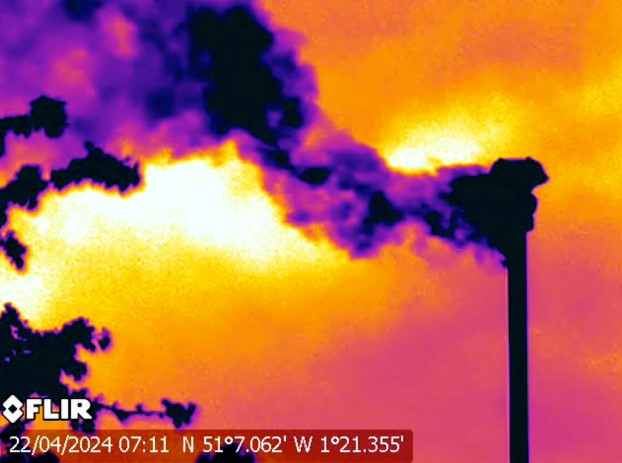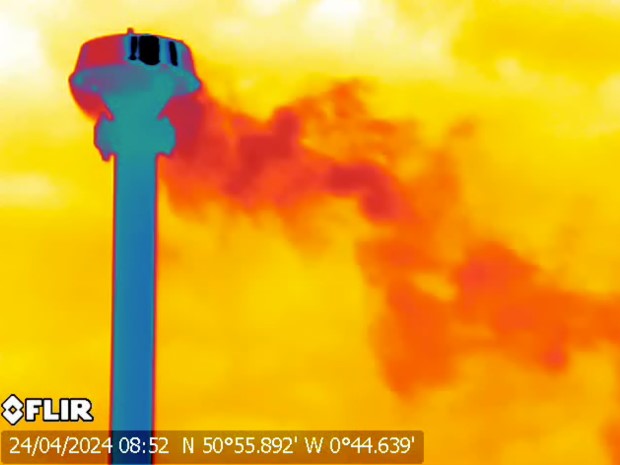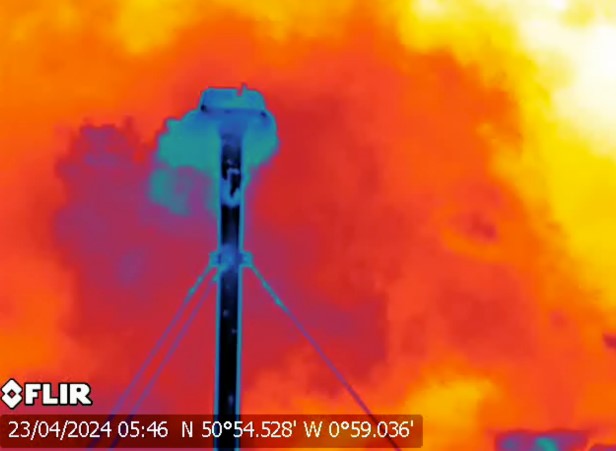Oil fields run by Star Energy, in or near the South Downs National Park, have been recorded emitting climate-changing gases for the third time.

The Clean Air Task Force (CATF) recently used a special camera to film releases at Singleton, north of Chichester, three sites in the Horndean oil field, near Portsmouth, and Larkwhistle Farm, part of the Stockbridge field, near Winchester.
The released gases included methane, said by the UN to be responsible for about a third of the global warming we are experiencing today.
CATF researchers had previously recorded methane emissions at these oil fields in 2021 and 2022.
The gases, also likely to include volatile organic compounds, are extracted as a byproduct, alongside oil.
All the fields recorded by CATF have official permissions to release unburnt gases through vents into the atmosphere. This is either in unlimited amounts or up to volumes specified by the Environment Agency.
The researchers also recorded emissions from oil storage and separator tanks (Larkwhistle, Singleton, Horndean B) and four cases of fugitive gas releases. These included what they described as “a significant and apparently unmonitored source at Singleton from the piping leading to the vent stack”.
Local campaigners have called for greater controls over the emissions.
The UK signed an international pledge to reduce global methane emissions by 2030. Some UK government advisors have recommended a ban on venting and flaring (burning waste gases) on oil sites by next year (2025).
DrillOrDrop invited Star Energy to comment on the CATF findings. The company did not respond.
Results
Singleton

At Singleton, in the South Downs National Park, CATF’s certified thermographer recorded continuous emissions of gas coming from four sources.
These included “continuous and significant emissions of associated gas from cold venting from the main vent stack” and emissions from the hatches of two oil storage tanks. Emissions from these tanks were also recorded in 2021 and 2022, CATF said.
A methane leak was also recorded, apparently from below ground, near the vent stack. CATF said there was no evidence to indicate that this had been spotted and dealt with by site staff.
Star Energy committed in Singleton’s environmental permit to provisions to:
“minimise the emissions of non-methane volatile organic compounds (NMVOC) and methane from the oil storage tank vent”.
Horndean

At Horndean, CATF recorded cold venting from the main vent stacks at all three sites, B, C and X.
At the B site, non-continuous emissions were also recorded from the top of the separator linked to the wellhead and a small leak on the piping of the separator tank. Previous surveys of this site recorded releases in 2021 and 2022. Emissions from Horndean X and C sites had previously been documented in 2021.
Larkwhistle Farm, Stockbridge
At the Larkwhistle Farm pad, CATF said it found continuous and significant emissions from cold venting from the main vent stack.
The results also included emissions from hatches of two oil storage tanks, a small leak from piping leading to the vent stack and large emissions during filling a tanker. Previous surveys in 2021 and 2022 also found emissions at Larkwhistle.
Reaction
CATF’s certified thermographer, Theophile Humann-Guilleminot, said:
“We have heard about operators’ commitment to reduce their methane emissions since 2021. Yet, year after year no improvement has been made on the fields: oil companies keep cold venting and pollution from associated gas has not slowed down the slightest. The UK has helped spearhead the Global Methane Pledge, but now, it needs to take action and address its domestic emissions.”
Emily Mott, of the Weald Action Group, which campaigns for methane reduction in the oil and gas industry, said:
“These ancient onshore sites are not producing much oil, use primitive and outdated equipment and are very polluting.
“We need robust environmental legislation and regulation around emissions with a ban on venting and flaring. The state of our nature and climate should be prioritised as we move away from dirty fossil fuels and focus on transitioning to renewable energy production.”
Philip Maber, a near neighbour of the Singleton site and founder of Singleton Forest Watch, said:
“The Environment Agency could easily stop these emissions, as is being legislated for across the EU and beyond.
“Our UK Government is dragging its feet in fulfilling the Methane Pledge Agreement signed up to at the COP 26 [climate conference] in Glasgow.”
Official data
The five surveyed sites have been operating since the 1980s. They are within an area of about 30 miles in West Sussex and Hampshire.
Oil fields send data on gas venting to the North Sea Transition Authority (NSTA). The figures are published monthly, three months in arrears. DrillOrDrop reports on the data at the beginning of each month. The figures do not include fugitive emissions so methane releases are likely to be higher than the official figures.
According to NSTA data, Singleton has vented 2-3ksm3 (thousand standard cubic meters) every month since venting records began in October 2016. The total vented by Singleton in that time is 236ksm3.
Official records from the Horndean field in Hampshire show it vented 7ksm3 in each of the most recent four months for which data is available (November 2023-February 2024). Before then, the field’s three sites vented a total of up to 24ksm3 a month. Since records began, the site has officially vented 1,522ksm3.
The Stockbridge field, which has three operational sites, has vented 397ksm3 since official records began nearly seven and a half years ago. The highest monthly total was 8ksm3 in September 2019. The past four months have each reported 2ksm3 or 3ksm3 of vented gas.
Onshore venting, like onshore production, is a small proportion of the UK total.
In February 2024, onshore vented gas volume was 2% of the total vented in the UK. This is about the same as the proportion of onshore oil production to the UK total.
The total volume of onshore vented gas in February 2024 was 81ksm3, compared with 5,119 offshore.
But Star Energy oil fields contribute a majority of the UK’s onshore vented gases.
The Singleton, Stockbridge and Horndean fields together represent 14% of the UK onshore venting total.
All Star Energy onshore fields across the UK vented two-thirds of the onshore total in February 2024. The largest volume came from the company’s Beckingham site in Lincolnshire (12ksm3), followed by Corringham (8ksm3), also in Lincolnshire, and Horndean (7ksm3).
Star Energy operates 15 of the top 20 highest venting onshore oil fields.
Methane
Methane is a powerful greenhouse gas, particularly in the short-term.
Its global warming potential is about 80 times greater than that of carbon dioxide during the 20 years it is released into the atmosphere.
The UN Environment Programme (UNEP) estimates that just over a third of human-driven methane is from fossil fuels.
UNEP said:
“Global methane emissions must be reduced by 30-60% below 2020 levels by 2030 to be consistent with least-cost pathways of limiting global warming to 1.5°C this century.”
It said:
“Investments needed in operational changes in the oil and gas sector are equivalent to less than 2% of income generated by oil and gas companies in 2022.”
The House of Lords environment and climate change committee is carrying out an inquiry into methane. It seeks to understand the impact of methane on climate change and UK progress on commitments to reduce methane emissions.
The committee has already heard evidence from researchers, regulators, the farming industry, and campaigners. There are two further sessions this month on Wednesday 15 and 22 May. Details
The Global Methane Pledge, launched at the Glasgow climate conference in 2021, commits participating nations to at least a 30% reduction in global methane emissions by 2030, compared with 2020 levels. More than 155 countries, including the UK, have signed up.
Research details
CATF used a FLIR GF320 infrared camera to scan the sites in April 2024. This is the industry standard equipment for identifying emissions and leaks. It has been calibrated and independently tested to detect and visualise the presence of at least 20 gases. The camera is primarily a qualitative tool and does not record the volume of gas in a release. Theophile Humann-Guilleminot, is a certified ITA Level 1 infrared thermographer, with hundreds of hours logged in the field.
DrillOrDrop has closed the comments section on this and future articles. We are doing this because of the risk of liability for copyright infringement in comments. We still want to hear about your reaction to DrillOrDrop articles. You can contact us by clicking here.
